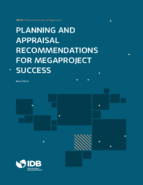Planning and Appraisal Recommendations for Megaproject Success
Date
Feb 2019
This paper compares two approaches to the evaluation of mega transport project success. The first one is called the “iron triangle” approach. Under this approach, a megaproject is considered successful when it is delivered on budget, on time, and in line with the required specifications. The second approach is here called the “holistic” view of megaproject success, which considers other commonly used criteria: social efficiency, effectiveness, equity, relevance, and political pay-off, among others.
This paper shows how the way in which the success of a mega transport project is measured leads to different recommendations for the planning and appraisal stages. It shows that such recommendations may or may not be consistent with the nature of the problem these endeavors imply at the different stages. It is here argued that focusing on the “iron triangle” approach to success can promote planning and appraisal with a narrow view of the problem, by assuming consensus, encouraging depoliticization, understanding the problem as a mathematical optimization made by a single decision-maker. The “holistic” approach to success, on the other hand, favors more comprehensive and integrated ways of planning and appraising infrastructure megaprojects. It does so by promoting a reduction in data demands, focusing on simplicity and transparency aimed at clarifying the terms of conflict and accepting uncertainty, keeping options open, all while focusing on the actual criteria used by the relevant stakeholders.
Common pitfalls of the application of the “iron triangle” approach to success at the planning and appraisal stages result from its failure to address the context and the usual impossibility to fix and maintain a desired state from the earliest stages of the project. On the other hand, when using the ”holistic” view, recommendations are based on what happens in fact, including project management variables as only one part of the criteria actually used when planning megaprojects. In order to promote a transparent pre-investment stage, the planning and appraisal of megaprojects should consider project management variables, while also accepting complexity and non-linearity, addressing the power of the context, as well as the influence of the stakeholders involved, reflecting the actual criteria used in the decision-making process.
This paper shows how the way in which the success of a mega transport project is measured leads to different recommendations for the planning and appraisal stages. It shows that such recommendations may or may not be consistent with the nature of the problem these endeavors imply at the different stages. It is here argued that focusing on the “iron triangle” approach to success can promote planning and appraisal with a narrow view of the problem, by assuming consensus, encouraging depoliticization, understanding the problem as a mathematical optimization made by a single decision-maker. The “holistic” approach to success, on the other hand, favors more comprehensive and integrated ways of planning and appraising infrastructure megaprojects. It does so by promoting a reduction in data demands, focusing on simplicity and transparency aimed at clarifying the terms of conflict and accepting uncertainty, keeping options open, all while focusing on the actual criteria used by the relevant stakeholders.
Common pitfalls of the application of the “iron triangle” approach to success at the planning and appraisal stages result from its failure to address the context and the usual impossibility to fix and maintain a desired state from the earliest stages of the project. On the other hand, when using the ”holistic” view, recommendations are based on what happens in fact, including project management variables as only one part of the criteria actually used when planning megaprojects. In order to promote a transparent pre-investment stage, the planning and appraisal of megaprojects should consider project management variables, while also accepting complexity and non-linearity, addressing the power of the context, as well as the influence of the stakeholders involved, reflecting the actual criteria used in the decision-making process.



